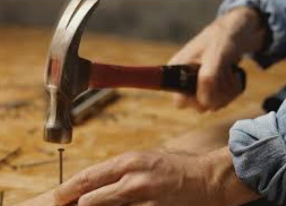There are many injuries while using hand tools on the job. Many of these injuries occur from improper use, but there are also injuries that involve a tool that was broken or in need of repair. What tool is being used will decide what needs to be inspected on it. In this safety topic we will discuss basic handheld tools that are not electric or pneumatic.
Common hand tools found on almost every jobsite and at home across the country are screw drivers, hammers, and wrenches. This is not an all-inclusive list, but these are some of the most frequently used hand tools.
Common Hand Tool Inspection Items
Hammers
Ensure that the handle is not broken or chipped. If a handle is taped, more than likely it is broken and needs replaced. On any tool, tape is not a manufacturer’s approved fix for a needed repair. Ensure the head of the hammer is tight on the handle. Throw the hammer away if part of the claw is broken off.
Screwdrivers
Ensure the handle is not chipped or broken. Many people will use the screwdriver as a chisel and hit the back end of it with a hammer. This causes damage to the screwdriver and will damage the handle. If the head of the screwdriver is chipped or worn down, replace the screwdriver.
Wrenches
Check that the wrench is not bent. Replace any wrench that is chipped or excessively worn. Losing the grip on a bolt due to a worn or broken wrench can easily cause hand injuries to the user.
General Hand Tools Best Practices
- Keep tools clean. Dirty tools are harder to use safely and properly.
- Do not modify hand tools. Keep the manufacturer’s design intact.
- Secure all hand tools and store them away properly. Tools left out are much more likely to get lost, stolen, or damaged.
- Use tools how they are designed to be used. This will keep the tool in good condition longer and you safe when using it.
